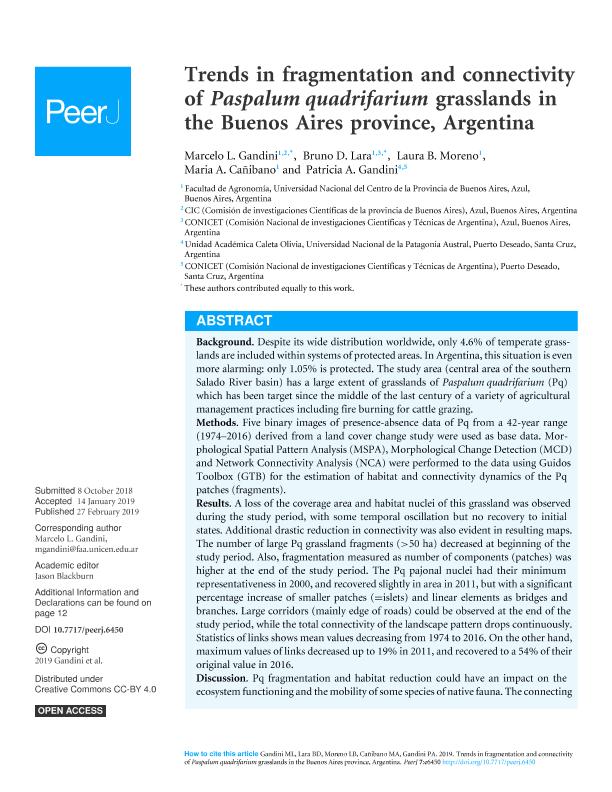Mostrar el registro sencillo del ítem
dc.contributor.author
Gandini, Marcelo Luciano

dc.contributor.author
Lara, Bruno Daniel

dc.contributor.author
Moreno, Laura Beatriz

dc.contributor.author
Cañibano, María Alejandra

dc.contributor.author
Gandini, Patricia Alejandra

dc.date.available
2021-02-26T17:37:42Z
dc.date.issued
2019-02
dc.identifier.citation
Gandini, Marcelo Luciano; Lara, Bruno Daniel; Moreno, Laura Beatriz; Cañibano, María Alejandra; Gandini, Patricia Alejandra; Trends in fragmentation and connectivity of Paspalum quadrifarium grasslands in the Buenos Aires province, Argentina; PeerJ; PeerJ; 2; 2-2019; 1-16
dc.identifier.issn
2167-8359
dc.identifier.uri
http://hdl.handle.net/11336/126821
dc.description.abstract
Background. Despite its wide distribution worldwide, only 4.6% of temperate grasslands are included within systems of protected areas. In Argentina, this situation is even more alarming: only 1.05% is protected. The study area (central area of the southern Salado River basin) has a large extent of grasslands of Paspalum quadrifarium (Pq) which has been target since the middle of the last century of a variety of agricultural management practices including fire burning for cattle grazing. Methods. Five binary images of presence-absence data of Pq from a 42-year range (1974–2016) derived from a land cover change study were used as base data. Morphological Spatial Pattern Analysis (MSPA), Morphological Change Detection (MCD) and Network Connectivity Analysis (NCA) were performed to the data using Guidos Toolbox (GTB) for the estimation of habitat and connectivity dynamics of the Pq patches (fragments). Results. A loss of the coverage area and habitat nuclei of this grassland was observed during the study period, with some temporal oscillation but no recovery to initial states. Additional drastic reduction in connectivity was also evident in resulting maps. The number of large Pq grassland fragments (>50 ha) decreased at beginning of the study period. Also, fragmentation measured as number of components (patches) was higher at the end of the study period. The Pq pajonal nuclei had their minimum representativeness in 2000, and recovered slightly in area in 2011, but with a significant percentage increase of smaller patches (=islets) and linear elements as bridges and branches. Large corridors (mainly edge of roads) could be observed at the end of the study period, while the total connectivity of the landscape pattern drops continuously. Statistics of links shows mean values decreasing from 1974 to 2016. On the other hand, maximum values of links decreased up to 19% in 2011, and recovered to a 54% of their original value in 2016. Discussion. Pq fragmentation and habitat reduction could have an impact on the ecosystem functioning and the mobility of some species of native fauna. The connecting elements of the landscape were maintained and/or recovered in percentage in 2011 and 2016. This fact, although favoring the dispersion of the present diversity in the habitat nuclei could cause degradation by an edge effect. Part of the area has the potential to be taken as an area of research and as an example of livestock management, since it is the one that would most preserve the biodiversity of the Pq environment. On the methodological side, the use of a proved tool as GTB is useful for monitoring dynamics of a grassland-habitat fragmentation.
dc.format
application/pdf
dc.language.iso
eng
dc.publisher
PeerJ
dc.rights
info:eu-repo/semantics/openAccess
dc.rights.uri
https://creativecommons.org/licenses/by/2.5/ar/
dc.subject
CATTLE GRAZING
dc.subject
MORPHOLOGY
dc.subject
GUIDOS TOOLBOX
dc.subject
SPATIAL PATTERN
dc.subject
NETWORK ANALYSIS
dc.subject
HABITAT LOSS
dc.subject
LAND COVER CHANGE
dc.subject
COMMUNITY REPLACEMENT
dc.subject.classification
Ecología

dc.subject.classification
Ciencias Biológicas

dc.subject.classification
CIENCIAS NATURALES Y EXACTAS

dc.title
Trends in fragmentation and connectivity of Paspalum quadrifarium grasslands in the Buenos Aires province, Argentina
dc.type
info:eu-repo/semantics/article
dc.type
info:ar-repo/semantics/artículo
dc.type
info:eu-repo/semantics/publishedVersion
dc.date.updated
2020-12-04T18:14:42Z
dc.journal.number
2
dc.journal.pagination
1-16
dc.journal.pais
Estados Unidos

dc.description.fil
Fil: Gandini, Marcelo Luciano. Universidad Nacional del Centro de la Provincia de Buenos Aires. Facultad de Agronomía; Argentina. Provincia de Buenos Aires. Gobernación. Comisión de Investigaciones Científicas; Argentina
dc.description.fil
Fil: Lara, Bruno Daniel. Universidad Nacional del Centro de la Provincia de Buenos Aires. Facultad de Agronomía. Departamento Ciencias Básicas Agronómicas y Biológicas. Laboratorio de Investigación y Servicios en Teledetección de Azul; Argentina. Consejo Nacional de Investigaciones Científicas y Técnicas. Centro Científico Tecnológico Conicet - Tandil; Argentina
dc.description.fil
Fil: Moreno, Laura Beatriz. Universidad Nacional del Centro de la Provincia de Buenos Aires. Facultad de Agronomía; Argentina
dc.description.fil
Fil: Cañibano, María Alejandra. Universidad Nacional del Centro de la Provincia de Buenos Aires. Facultad de Agronomía; Argentina
dc.description.fil
Fil: Gandini, Patricia Alejandra. Universidad Nacional de la Patagonia Austral. Unidad Académica Caleta Olivia; Argentina. Consejo Nacional de Investigaciones Científicas y Técnicas; Argentina
dc.journal.title
PeerJ
dc.relation.alternativeid
info:eu-repo/semantics/altIdentifier/url/https://peerj.com/articles/6450
dc.relation.alternativeid
info:eu-repo/semantics/altIdentifier/doi/http://dx.doi.org/10.7717/peerj.6450
Archivos asociados
